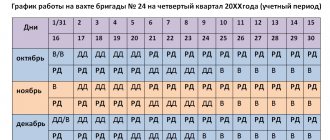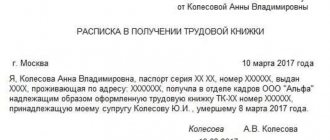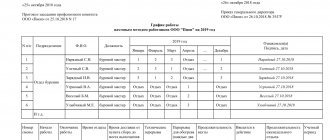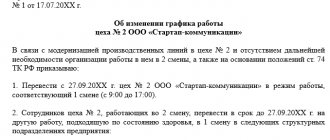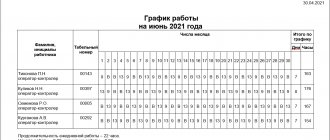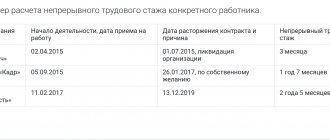The legislative framework
In accordance with Article 297 of the Labor Code of the Russian Federation, if it is impossible to ensure that personnel return home every day, they are asked to keep a watch. In this case, the employer is obliged to organize a special settlement where workers will live until the completion of their functions.
The Labor Code of the Russian Federation recommends the rotation method of work in the following situations:
- The activities are carried out in an area sufficiently remote from the personnel’s place of residence.
- The facility is located far from the main location of the employer.
- You will have to work in uninhabited or difficult conditions.
- It is necessary to reduce the time until the completion of the project (most often construction or reconstruction).
Legislation allows for other reasons. In any case, as the Labor Code prescribes, the rotation method and the procedure for its application must be agreed upon with the trade union (if there is one). The decision should be formalized by order and recorded in a local act of the organization.
Allowances and surcharges
The size and procedure for paying the bonus are established by law and are based on the Labor Code (Article 302 of the Labor Code of the Russian Federation), but there are also some nuances. So, premiums are set depending on funding (state, budget, private, and so on):
- The Government of the Russian Federation for employees of organizations financed by the federal budget.
- Bodies of local government and self-government for budgetary subjects of the Russian Federation.
- Collective agreements, local acts and orders of organizations and trade unions for employees of organizations not financed from the budget.
- The amount of the bonus is established by law (Resolution of the Government of the Russian Federation No. 51 of 02/03/2005) for budgetary organizations:
- in the Far North and equivalent regions - 75% of the tariff rate (salary);
- in Siberia and the Far East (and other similar natural and climatic regions) - 30% of the tariff rate (salary).
Compensation for irregular working hours
The law does not indicate that the employer must pay compensation for irregular working hours. Some organizations establish such payments by issuing a local order and consider them as overtime. Most often, for overtime hours worked, hours or days are added to the annual paid leave. This point, how irregular working days are compensated, what compensation is implied, should be discussed with each employer individually in advance.
Allowances for work in difficult working conditions
Employees who work in the Far North or in regions equivalent to it are entitled to a separate allowance. This bonus is not related to the rotational method of work, that is, it is considered separately, regardless of the work schedule of an employee of a particular organization and is a compensation payment. The calculation of this allowance is regulated by the Labor Code of the Russian Federation.
Providing additional vacation days
Employees working on a rotational basis have the right to receive not only 28 days of annual paid leave, which labor legislation provides, but can also count on additional paid leave if the employee works in the Far North (24 calendar days) or in a region equivalent to it (16 calendar days).
Specifics of the organization
The Labor Code describes the peculiarities of work on a rotational basis in the form of restrictions, special regimes of work and rest, as well as their duration.
In accordance with Article 298, it is prohibited to involve the following categories of citizens in labor in this form:
- children and adolescents;
- pregnant women and young mothers (until the child is three years old);
- adult men and women with medical contraindications.
Based on the results of a medical examination, a ban can be obtained by people with diseases of the heart, nervous and hematopoietic systems, hypertension, as well as patients suffering from disorders of consciousness.
What is a shift work method?
Traditionally, the rotation method is a shift activity, seasonal, temporary or permanent. There is no need to confuse shift work and shift work. Shift workers cannot go home after the end of the working day and remain to live for some time in the production itself, while shift work is when they have completed working hours and gone home.
More frequent vacancies are in the Far North and its sparsely populated areas, where there is production. If you search on the Internet, you can find many rotational vacancies, both for specialized qualified specialists and for simple general workers, cooks, and security guards. The main direction is production and industry:
- Logging.
- Mining of oil and gas.
- Exploration and production of minerals, precious metals, coal deposits, etc.
- Railway transport.
- Fish farming and others.
What is the reason for the popularity of the method? The main function is the need and order of the employer for a large number of employees. Although such work is paid more expensively and requires more expenses, the industry employer is ready to provide workers with all the necessary conditions and provide all payments. After all, the main criterion is the result - a well-established production process without failures or interruptions (for example, when producing petroleum products, it is important to comply with all technical and time deadlines).
Where is this type of employment most common? In first place are hard-to-reach and sparsely populated areas in Russia - for example, in the Far North. Reconstruction and construction of large objects of industrial or cultural significance, their further support and maintenance, is carried out by rotation workers. Extensive experience is not required. Attracting foreign citizens for employment in factories, manufacturing factories, and in the service sector is also work on a rotational basis.
Work and rest schedule
The shift work schedule of the Labor Code of the Russian Federation presupposes being on site for a maximum of a month, as Article 299 states. This period includes rest time between shifts. For example, one team works in the morning and in the first half of the day, the second in the second half and in the evening, and the third at night. While one is busy, the other two are restoring strength.
If agreed upon with the trade union, the shift period can be extended to three months. But for this there must be unconditional arguments.
The work schedule, as prescribed by Article 301, follows:
- discuss and agree with the trade union;
- present to employees;
- put into effect no earlier than two months after familiarization with it.
When organizing, it is necessary to focus on Resolution No. 794/33-82 of the State Committee for Labor of the USSR, the Secretariat of the All-Union Central Council of Trade Unions, and the Ministry of Health of the USSR dated December 31, 1987.
It is more convenient to keep track of working hours in a summarized way. You can choose the period that is most convenient, but no more than a year. When distributing shifts, the following standards must be observed:
- duration of the working day - no more than 12 hours;
- the duration of rest between shifts is at least 12 hours;
- for each week - at least one day of rest on any day of the week.
On pre-holiday and pre-weekend days, employees have the right to a shortened shift.
It is recommended to include all conditions in the employee’s employment contract.
Watch and personnel
An employer who uses a rotational method of organizing labor and paying for it has a number of obligations to employees in accordance with the law:
- tracking the working time of each employee on shift (duration - no more than a month, in exceptional cases - up to 3 months);
- summary recording of working hours;
- provision of housing and three meals a day;
- organization of medical examinations, payment of sick leave;
- payment not only for labor, but also for travel to the place of work, the use of a number of allowances for labor;
- advance preparation and approval of a work schedule and familiarization of employees with it, with a shift duration of no more than half a day.
Attention! The duration of the shift is calculated in total with the rest time from shift to shift (Labor Code of the Russian Federation, Art. 299).
Employees must be familiarized with the schedule no later than two months before starting work. The document must be approved by the trade union of the employing organization. When drawing up a schedule, you should keep in mind that working without a rest break, in two shifts in a row, is strictly prohibited.
Question: Is it possible to extend the shift period with the employee’s consent by 14 days and increase the accounting period established for the quarter? View answer
Shift workers may be provided with the following types of payments:
- salary;
- allowance for the shift, taking into account travel time for each day of the shift;
- payment for overtime between shifts;
- coefficients for complexity, work intensity, hazardous working conditions, depending on the industry;
- “climate” allowance, if work is carried out in the corresponding regions, the so-called northern one, etc.
Attention! The shift bonus has a fixed amount only for employees of federal structures (30% - general rate, Siberia, Far Eastern region - 50%, Northern region - 75% of the average daily rate). Commercial structures set its dimensions independently.
All working and rest conditions must be clearly stated in the employment agreement, collective agreement, and other legal acts of the organization. In accordance with labor legislation, the following are not allowed to work on a rotational basis:
- pregnant women;
- minors;
- persons for whom a certain climate is harmful for medical reasons;
- women with children under 3 years of age.
Question: What type of income code should I indicate in a payment order when transferring to an employee an allowance for shift work, which is paid in exchange for daily allowance? View answer
Payment for work on a rotational basis under the Labor Code of the Russian Federation
The payment scheme depends on the system being used. For piece workers - for the volume completed, based on complex standards, for time workers - for the hours actually worked.
Increasing coefficients for special working conditions are established in accordance with the region in which the direct activity is carried out. Even if the head office is located in the center of Moscow, this is not a reason to cancel them.
Additionally, watchmen are entitled to the following guarantees (in accordance with Article 302):
- allowance for travel time to the place of duty;
- compensation in the amount of the daily rate for each day of delay on the road;
- provision of food and household services;
- extra days of vacation when working in the Far North or equivalent regions.
Before going on vacation, an employee must take all earned time off that he has received by saving rest time between shifts. If he quits before using them, he will receive the cash equivalent.
Shift work schedule - what is it?
When using a VM at an enterprise, a schedule is created for the entire accounting period, including work time and rest between shifts.
Basic principles that must be taken into account when creating a schedule for a VM:
- rhythm of the production process (even distribution of workload and rest);
- the normal (established by the Labor Code of the Russian Federation) duration of the working week is 40 hours or otherwise (for certain categories of workers, for example, those working in hazardous and difficult working conditions, a shortened working week may be provided - 36 or 24 hours);
- working time is calculated according to the principle of cumulative working time;
- the duration of the shift cannot be longer than 30 days (up to 3 months - upon agreement with the enterprise’s trade union in case of production necessity);
- the duration of a work shift during a shift cannot be longer than 12 hours;
- the rest time between shifts cannot be less than 12 hours (clause 4.3 of resolution No. 794/33-82);
- Persons under 18 years of age, pregnant women, women whose children have not reached 3 years of age, and persons whose health does not allow working on a shift cannot be involved in the work of the VA;
- overtime (overtime) can be summed up and taken into account in calculations: reimbursed by additional days of rest or additional payment for overtime hours;
- the employee’s time traveling from home to the place of departure for shift is included in the inter-shift rest period.
You can refresh your knowledge regarding the provision of part-time work by reading the article “To whom and when is part-time work established?”
Work on a rotational basis according to the Labor Code of the Russian Federation and its advantages
Like any form of labor organization, it has its pros and cons. From an employee's point of view, the main advantages include:
- Increased earnings.
- The ability to choose an activity without being tied to your place of residence.
- Savings on rent and food and the resulting opportunity to save.
- Long rest after each watch.
The Labor Code of the Russian Federation strictly regulates the shift method, which means that there are no more risks when working away from home than in an office next door. So the only drawback can be considered the poor infrastructure of the villages and the inconvenience of the schedule for family people. Although the advantages significantly outweigh them.
Order
Basic theses about shifts according to the Labor Code of the Russian Federation
The list of structures that have the right to use rotational work is established by Resolution of the State Committee for Labor of December 31, 1987 No. 794/33-82:
- Subjects of the oil and gas industry.
- Construction education.
- Public catering places.
- Transport companies.
- Subjects of health protection.
Question: Is a shift bonus accrued while an employee is in a rotational housing complex during rest between shifts? View answer
The concept of the considered method of work is disclosed in Article 297 of the Labor Code of the Russian Federation. This is a type of work organization in which an employee works far from his place of residence and cannot return home. The shift is used to reduce the delivery time of the project, if it is necessary to work in uninhabited areas and in areas with special natural conditions. The decision to use a given method of work is made if it will be most effective in this situation. To determine the effectiveness of the method, technical and economic calculations are used. The rotation method can be established both for the entire company and for certain teams and locations.
ATTENTION! The employer is obliged to provide employees with all conditions for comfortable work during shift conditions. In particular, he must build workers' towns or villages in which workers will live. A dormitory can be used for workers' accommodation. It is paid by the employer. This rule is stipulated by part 3 of article 297 of the Labor Code of the Russian Federation. In any case, the accommodation of employees is the responsibility of the employer.
